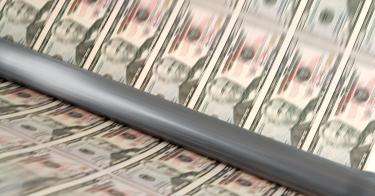“Many of the great disasters of our time have been committed by experts,” the economist Thomas Sowell once said. Looking at the way prices are rapidly rising across the U.S. economy, it’s hard not to think of his words.
President Joe Biden assured Americans in July that “no serious economist” expected unchecked inflation. Today, the public is more concerned with inflation than any other issue.
In February, the government’s inflation forecasts for the year were at or below 2 percent. As of October, year-over-year consumer price increases have reached a 31-year high of 6.2 percent—triple the official prediction. Producer prices are up 8.6 percent.
A series of deficit-financed spending packages adding up to $6 trillion (so far) have contributed to rising prices. Only recently, with prices across the economy climbing, has Biden acknowledged that the trend of higher inflation is hitting people’s pocketbooks.
>>> With Inflation Raging, Congress Must End Spending Spree
And yet his administration is doubling down on spending. The House is considering a massive social spending package that would spend another $2.4 trillion (double that if the new programs aren’t assumed to expire).
Incredibly, the administration is selling the budget-busting plan as a solution to inflation. White House economic adviser Brian Deese claimed, “If your principal concern is inflation, the Build Back Better agenda is exactly designed to relieve those price pressures over time.”
Biden has pointed to a letter from 17 left-wing Nobel laureate economists that supposedly agree with his dubious claim that the bill would “ease inflationary pressures.”
But this letter was written about a very different version of the bill, and it wasn’t referring to near-term inflationary pressures. Several of the signatories are now more pessimistic (or at least noncommittal) about whether the current plan would help or hurt long-term inflation.
Proponents claim that this bill (unlike most spending bills) would curb inflation, because it is “paid for.” However, it is “paid for” only in the same sense that a car is paid for if you have a lease payment plan. It would take three years just to pay for the first year of spending in the bill.
This is the game in Congress: Put entitlements in place now, and force a future Congress to figure out how to pay for it.
Biden and congressional Democrats don’t intend to stop funding the new entitlements. Not after one year, one decade, or one century. If the spending was truly meant to be temporary, why is the White House promoting it by creating cartoons depicting cradle-to-grave government handouts spanning multiple generations?
They can’t have their cake and eat it too. If the Build Back Better plan is permanent and transformative, they need to exhibit the intellectual honesty to admit they are saddling the economy with never-ending deficits and, likely, even higher prices.
Even if the plan was fully paid for, much of this plan only exacerbates rising prices.
As the economy struggles with a labor shortage, the plan would push hundreds of thousands of workers out of the private sector and into government bureaucracy at the IRS and various regulatory agencies.
Government agencies would exert more control over the private sector through federal grant money. Instead of competing for price-sensitive customers, many private companies would focus on competing for billions of grant dollars from cash-flush federal agencies. None of this would help put products on empty shelves.
One thing necessary to put products on shelves is affordable, reliable energy. Biden recently pointed to the economic pain caused by surging gas prices: “Did you ever think you’d be paying this much for a gallon of gas? In some parts of California, they’re paying $4.50 a gallon.”
>>> Congress’ Wasteful Spending Spree Must End With Infrastructure Bill
Yet Biden’s plan would in many ways replicate California’s failed approach to energy policy: subsidize commercially unviable technologies and penalize production of oil and natural gas. It gives the EPA more regulatory authority to crack down on oil and gas companies. It even bans new production of oil and gas off of nearly all of America’s coastline.
When asked on Bloomberg Television what her plan was for increasing oil production, Energy Secretary Jennifer Granholm burst into laughter exclaiming, “That is hilarious!” For Americans struggling to fill up their gas tanks, it isn’t.
However, the fundamental problem of the spending plan is this. No individual or group of experts has godlike powers that allow them to micromanage the economy better than 300 million people acting on their own behalf—working, buying, selling, and living how they see fit.
This piece originally appeared in the Atlantic City Press




